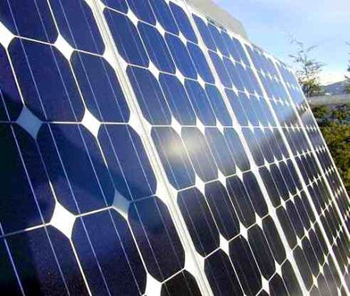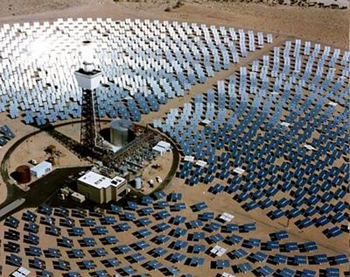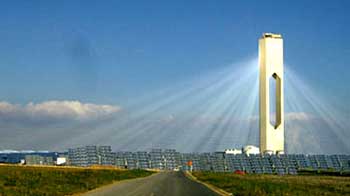Renewable Energy in Morocco
Ministry of Energy, Mines, Water, and Environment, Minister, HE Amina Benkhadra
In our evaluation for the short, medium, and long term, the demand for primary energy will double by 2020 and will triple by 2030.
Interview with HE Amina Benkhadra, Minister of Energy, Mines, Water, and Environment

Morocco is the largest energy importer in North Africa. In 2008, total costs related to energy imports reached 8 billion, according to some sources. How dependent is Morocco on imports, and what has been the development of the energy bill so far ?
Morocco has a great dependency on imports. We import 95% of our needs from different sources, including fuel, oil, gas, and this dependency has a great impact on the energy bill. By 2008, the energy bill was 48 billion dirhams, and by 2009 it reached 62 billion dirhams. So we are highly impacted by the volatility and the high prices. For this reason, Morocco has compensation fund which limits the impact on the population and the quality of life in the country.
The electricity demand will double by 2020 and will quadruple by 2030. This should give you an idea as to how big the demand is. We have prepared a new strategy to meet these needs, and a new plan for equipment to meet our objectives.
To reduce this dependency, the government has come up with a strategic plan to invest in renewables, especially in solar and wind energy. By 2012, you are aiming to produce 20% of electricity generation from these renewable sources. How do you intend to attract investors to these sectors, and what do you think are the biggest obstacles in your way ?
First of all, due to the economic and social growth that our country has undergone over the last decade, with big economic reforms and new developments in different sectors, such as agriculture, industry, infrastructure, and tourism, the demand for energy is increasing by 5% a year for primary energy and almost 7% for electricity. In our evaluation for the short, medium, and long term, the demand for primary energy will double by 2020 and will triple by 2030.
The electricity demand will double by 2020 and will quadruple by 2030. This should give you an idea as to how big the demand is. We have prepared a new strategy to meet these needs, and a new plan for equipment to meet our objectives. Our strategy is based on three main orientations : securing availability of energy at the best cost for all the people in all the country ; secondly, the integration of Morocco in the Euro-Mediterranean area and the Maghreb; and, then considering this development in a sustainable development way. To secure this energy, we have decided in accordance with the vision of His Majesty to develop our renewable energy since Morocco has a big potential for wind and solar energy. His Majesty has launched two main programs for solar and wind energy.
Both plans aim to construct 2,000 megawatts of new electric capacity by 2020, and by 2020 renewable energy will represent 42% of the total capacity. Those big projects will need an investment of 12.5 billion dollars, and we have decided to construct them in a partnership between public and private companies, and bring in to Morocco investors from any area of the world, which have expertise and the capacity to finance. Since the announcement of this project, we have had discussions with a pool of financial institutions, like the World Bank, the IFD, the European I nvestment Bank, JICA, KFW from Germany ; all these institutions are highly interested in financing the project.
nvestment Bank, JICA, KFW from Germany ; all these institutions are highly interested in financing the project.
Morocco has also organized the environment to attract companies and investors ; we have promulgated a law for renewable energy, we have created a dedicated agency to construct this solar plan, which is the Moroccan Agency for Solar Energy, and we have considered the solar and wind projects as integrated projects.
We want to construct industry around solar and wind equipment, to attract industries and investors, and for this we will offer very good incentives within specific industrial areas dedicated to the new energy. For instance, we have prepared a special offer in Oujda for investors with very easy access to land with specific support to the investment, up to 20 million dirhams. We have also considered the possibility of giving subsidies to those who bring training.
How does the support work in practice ? And what has been the response from the international investment community about these plans ?
If we take the solar plan, we are working on the first part of the plan in Ouarzazate and began attracting the interest of investors. We put what we call a « manifestation of interests ,» and received 215 bids. In July of this year, we made a prequalification, and received 17 consortium, each one composed of two or three big companies. We are in the process of this prequalification where the biggest companies of the world have submitted offers.
The official international tender will be launched by the end of this year. In this process, we put several criteria : on the technical side, because we need people that have both expertise to construct a plant of such capacity, and financial capability. For this first station, we are working with this consortium of financial institutions that I spoke about, and which are all dedicated to constructing the best investment plan for this first part of the Ouarzazate plan. Morocco will also bring all the concessional loans for the project to facilitate the investment. For the solar plan, we are also looking at the possibility of exporting a small portion, maybe less than 10% of the electricity to Europe, and are discussion how this can be accomplished legally and financially.
By the end, if there is a gap between the price, the state will help in covering the gap. For wind energy, we have a little experience, since we have 280 megawatts installed ; we have 720 megawatts und er construction by the private sector, and we have the national plan of 1000 megawatts. We launched the first station and received 27 offers by last week. All the biggest companies in wind energy have submitted offers and are ready to invest and develop that project, that will be done the IPP way. I think both projects are sufficiently important and interesting to attract investors. We will put on several industrial areas dedicated to the project, facilitating the investment and with some incentives on the land, fiscal, and educational aspects.
er construction by the private sector, and we have the national plan of 1000 megawatts. We launched the first station and received 27 offers by last week. All the biggest companies in wind energy have submitted offers and are ready to invest and develop that project, that will be done the IPP way. I think both projects are sufficiently important and interesting to attract investors. We will put on several industrial areas dedicated to the project, facilitating the investment and with some incentives on the land, fiscal, and educational aspects.
What are the main challenges in accomplishing your goals?
We have very strict deadlines. Our first plan of Ouarzazate has to be producing by 2020, so the Ministry and the public organizations in charge are totally dedicated to constructing this in time. Discussing the possibilities of investment and also looking at what is happening in development and innovation, especially for solar energy, which has had no accelerated growth in the past year in terms of research, innovation, and better performance in the electric plant for CSP. We hope research grows and continues to have better performance in the short and medium term which can help lower the prices of investment or cost of production.
You are building one large dam and five smaller dams in order to reach the 42% by 2020. Can you speak a bit more about water and the dams ?
We have planned a new strategy for water since water is also a challenge for Morocco due to our geographical location and climate, which is arid. Our strategy is built on two main aspects : first, to construct a diversified portfolio of water, which is itself based on three or four choices. The first is the conventional subsurface water which we get from the construction of dams. We will thus continue our old policy of dams which has brought very good results to the country since the 1950’s and 60’s.
It will continue with the construction of two or three big dams and fifteen to twenty small dams a year. The small dams will help fight the impact of inundations. The second aspect is the collecting of used water, treatment, and re-utilization for green areas. The third main point is the transfer of water from areas where you have basins, or an excess of water, to those where you have less water. For this, we are dealing with a feasibility study for a transfer project.
a transfer project.
The fourth option is the desalination, which will be very important in the future. We have small desalination plants in the south of the country in Laayoune, Boujdour, and Agadir. We are going to construct a bigger one in Casablanca by 2020, the capacity of which will be 4 million cubic meters a year. For this, a feasibility study is also underway. At the same time, we will deal with water efficiency in the use of water. The main user today is agriculture which also has the biggest waste. With the new green plan for agriculture, we are transforming from gravitation to drop-by-drop irrigation methods. These new techniques will limit the losses of water. We also have communication programs with residential partners, the industries, the tourism sector, to help them limit their water losses. Those programs are underway now.
What is the specific role of Hydro-carbons and Mines? What are the potential hydro-carbon reserves in Morocco?
It is the public organization in charge of exploration and promotion of mining and oil and gas production – except for phosphate. We deal with all the primary products. We conduct the first step of exploration or mining for oil and gas. Morocco has large sedimentary basins, but unfortunately, they are under-explored. We are convinced that due to the knowledge of geology that we have right now, there is potential that just needs to be developed by more investment. We have been dealing with a new dynamic for the last ten years, since the promulgation of the new oil and gas code, which was promulgated by 2000.
This code has very interesting incentives for foreign companies and one of the main points of the code is the fact that the partner has 75% of the capital of the new company if there is a discovery. This new code helped us attract several companies ; right now, we have 28 companies working in different areas but we need to accelerate drillings. The last offshore drilling we did cost 80 million dollars.
Our main constraint is the investment in more drillings. The areas where we have done sufficient drillings we have made discoveries, and we hope to continue our promotion work to attract more companies an d bring new investment here. In the past three or four years we have discovered small quantities of gas in the Gharb area, between Rabat and Meknes. We have also discovered, for the first time, gas in the offshore area, and some light gas in the Eastern area. We need to continue our efforts and attract more investment in this sector.
d bring new investment here. In the past three or four years we have discovered small quantities of gas in the Gharb area, between Rabat and Meknes. We have also discovered, for the first time, gas in the offshore area, and some light gas in the Eastern area. We need to continue our efforts and attract more investment in this sector.
Does Morocco offer viable production of oil from unconventional sources ?
Morocco has big reserves of oil shale, that have been discovered in the 70’s and 80’s. We did a lot of work, but the unconventional sources do not yet have an industrial process to produce oil and gas. Oil shale is used in small countries like Estonia to produce electricity, and there is a semi-industrial process in places like Brazil which is producing oil and gas from oil shale. We worked on this product during the 70’s, 80’s, and up until 1996.
With the downturn of the oil prices, the work stopped worldwide, including Morocco. By 2004-05, we returned to the process and by 2008 stopped again. We have signed recently several partnerships with PetroBrass and Total to test our oil shales, and with other companies. However, there is not yet a specific industrial process that can produce industrially oil and gas. We keep it open to the evolution of the process, and the technical development, and we have several partnerships. If there is any evolution we will look at it immediately.
What is your message to investors and the international community ?
Morocco has a privileged geographical position that situates it as a regional hub and allows it to play a key role in the area. We are inter-connected with Spain, Algeria, and are working on reinforcing the connection with Mauritania. Due to this geographical position, Morocco is ideal to partner with, especially in the energy sector, where the challenges are big and we have voluntary strategies with good and practical plans for renewable energy.
These plans give important opportunities to investors to bring their expertise to Morocco. Morocco will give them all the facilities, an industrial zone, support and incentives, to have them install their equipment, and we want to consider those projects as leading projects of industrialization, job creation, and positioning Morocco as a leader of research and innovation.
Morocco is a great place for companies to be, to achieve the objectives of the Moroccan strategy, but also to use Morocco as a platform for the Maghreb area and the sub-saharan countries. We also have a good environment of life and conditions. It is a good place to be.